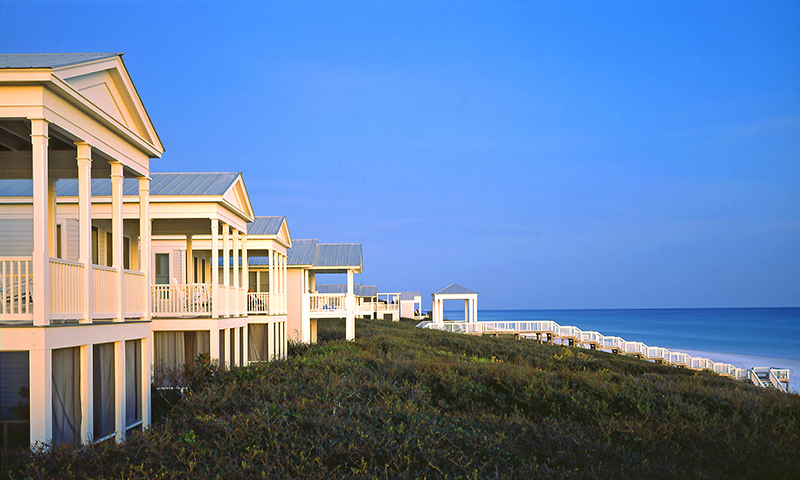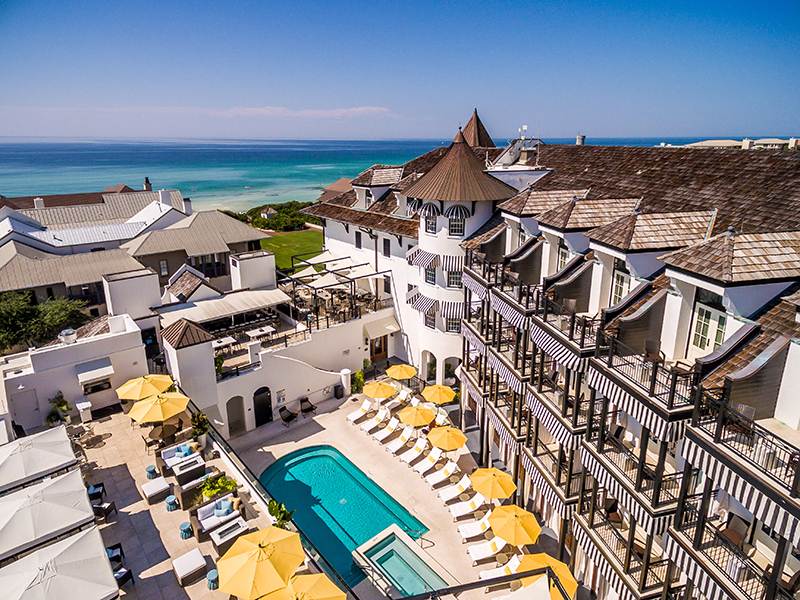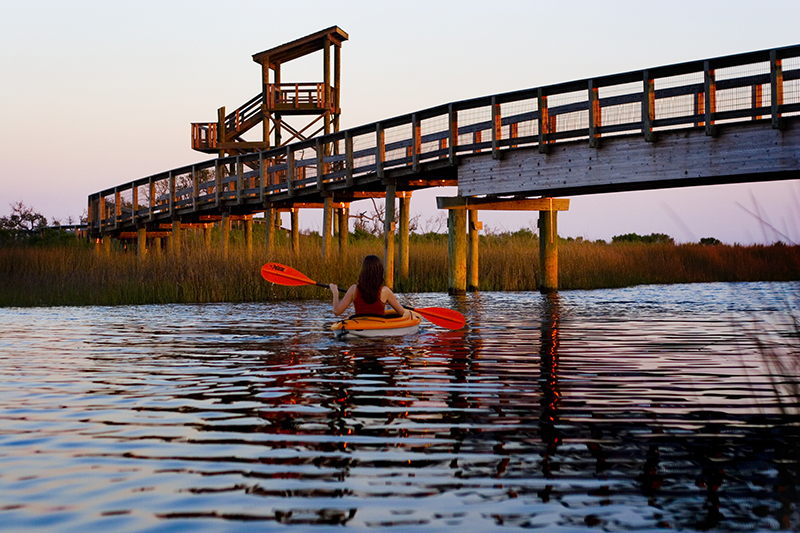
The U.S. may not have many designated blue zones, where people have been documented to live the healthiest and longest lives on earth, but it does have its green zones. These are the places that are visibly greener and lusher, covered by forest or carved by verdant rivers.
Flying over the Florida panhandle, all I see is green. Leafy tropical wildlands give way to cloud-white sands that melt into Gulf of Mexico waters ranging in shades from seafoam to jade to myrtle. A stone’s throw from Alabama and a three-hour drive from New Orleans, the roughly 100-mile patch of paradise aptly called the Emerald Coast is also a southern charmer known for barbeque shrimp and sultry nights.
I am not sure what to expect when I arrive, but I feel it when get there—the warm sea air is an instantly relaxing tonic. The sun is setting and there’s a cacophony of sounds that has the vibe of an awakening. Night birds sing. Frogs croak. Crickets chirp. In these parts, the pull to be outside is strong and seductive. It makes sense that this region, long-beloved by Southerners on sojourn, is quickly becoming a hub for an active, mindful lifestyle. The key to finding magic here is not to rush. In fact, it’s a natural setting to practice the art of slow travel, which really is more a way of being present than actually practicing anything at all.
Sound complicated? It’s not. An offshoot of the slow food movement, the idea of slow travel took root in the 1980s. In today’s hyperspeed, high-tech, experience-it-all world, slow travel is gaining momentum. Florida’s Emerald Coast is the deepest of the deep south with long hot days and sparkling beaches—the perfect place to immerse yourself in the lazy river of life.
Seaside: A Deep Sense of Place

The idyllic setting for 1998’s The Truman Show, Seaside in South Walton nods to Martha’s Vineyard with its white picket-fenced pastel cottages and small-town vibe. The master-planned community, completed in 1985, is considered a feat of modern New Urbanist Design, anchored by a town square flanked by a landmark post office and a variety of food trucks— most of them silvery Airstreams. Radiating from the center, boardwalks nestled up to manicured flowerbeds and pedestrian alleyways offer diversions from yoga studios and bike rental shops to boutiques and alfresco bars with sea views. Keep walking, and Santa Rosa Beach’s epic stretch of powder white is dotted with blue umbrellas, provided respite for folks on a break from a vigorous swim or SUP outing.
To prepare for long bike ride and trekking the trails of Grayton Beach State Park, I fuel up with an Almond Love smoothie at Raw & Juicy, a shiplapped corner juicery with a food truck outpost on the main square. The morning’s mildly sauna-like weather is tempered by the freshest breezes and the wind against my face as I whiz past the tranquil waters of a placid lake, lily pads on the surface and alligators underneath. The dunes in the distance—the largest concentration of coastal dunes on the planet—are a fortress along the water. The four-mile ride is capped off by a naturalist-guided trek under a canopy of young and old pine trees, undisturbed by the midday heat. Sense of place runs deep here.
The coast’s main drag, a scenic two-lane road called 30A runs along the Gulf and flanks the beach towns east and west of Seaside. Watercolor, to the west, boasts some of the region’s most serene beaches and walking and biking trails. Twenty minutes east, Rosemary Beach beckons with West Indies style—brightly painted buildings and a lively street scene. The cobblestone streets and alleyways are lined with casual cafes, bars and shops that conjure chic, Caribbean seaside towns. On Sundays, the 30A Farmers Market serves up fresh local produce, the catch of the day and foods from around the world.
A Swanky Stay, A Spa & A State Park

The swank, 55-room The Pearl beckons with black and white cabana-striped awnings and resident restaurant Havana Beach Club, whose Executive Chef James T. Neale II has remixed Gulf traditions and Cuban flavors with his passion for locally procured, hyper-seasonal fare. It’s enticing to head to the sea. And it’s so gorgeous, why not? Although the boutique offers ample outdoor amenities like kayaks and stand-up boards, a spot on the sand is in high demand. Spa Pearl focuses on restorative treatments, from addressing seasonal issues like sun-parched skin to incorporating tropical ingredients like pineapple, papaya and coconut milk to renew and nourish the skin.
To completely unplug, go solo to the tiny peninsula of Camp Helen State Park. Just a five-minute drive from civilization, this untouched and remote-feeling historic site spreads out between the Gulf of Mexico and Lake Powell, the state’s biggest coastal dune lake. At different turns this land was resort for employees of the now-shuttered Alabama-based textile mill (1945-1987) and a private residence. But there are indications that humans inhabited it as far back as 4,000 years ago. Wind along the hiking trails, hire a canoe or go for a swim.
Destination: Destin
Destin’s beaches are a wonderous, endless expanse of sugar-white sand and wild dunes. I make it a point to take long walks here, partly in hopes of seeing nesting turtles and partly to see how far I can go. The Henderson Beach Resort offers the right balance of indulgence and access to the ocean flanked by a sprawling nature preserve. Here, I rise with the sun and the hotel’s healthy breakfast bento (yogurt, granola, fruit, and baked egg), and start the days with back-to-back outdoor spin and yoga classes. Salamander Spa’s treatments incorporate homegrown ingredients, like sea salt and fresh, cooling aloe-vera, both bountiful in these parts. The 10,000-square-foot oasis features a Himalayan salt room, which is the spot to detox from whatever ails you cocooned by the warm air and a soothing pink glow.
America’s Oldest Settlement

Worlds away from the coast’s planned resort communities, Pensacola is the America’s oldest settlement, established as a Spanish Colony in 1559. Wander the revitalized downtown and take in a variety of architecture that charts the cultures influenced the city, including British, French, and Native American. French quarter-style romance mixes breezily with typical Southern shotgun houses. Hipster-packed breweries and harborside eateries dish fresh oysters and scrumptious crab cakes. Beyond the mainland, there are a plethora of ways to spend lazy days, kayaking in serene silence of Big Lagoon State Park or napping on a rare, Condor catamaran floating on calm green waters.
Even with all these options, there is plenty of time to sit on a porch, stare at the waves or watch an array of birds frolicking in the treetops. Which perhaps is the lesson I take from the area’s laid-back, good-timing Southern culture. There’s plenty of good reasons not to do anything at all. A chance to be alone in nature or ensconced in a quiet spa, is a rare and inspiring treat — the antidote to all that doing doers do on vacation.
Personalize Your Stay
One of the best ways to personalize and experience the Emerald Coast is to rent a private home. Choices range from cottages in Seaside, via Cottage Rental Agency, to grand waterfront mansions on secluded islets. Even better, you can arrange for private chefs, personal trainers and expert-guided excursions if that is your preferred way to go.
Martine Bury
Martine Bury is a writer for C, Sunset, and LALA, and editor of the luxury travel quarterly Quest. A native New Yorker turned Angeleno, she began her journalism career at Travel & Leisure, which spawned a lifelong passion for finding beauty and personal stories in every corner of the world. Hence, the journey continues.